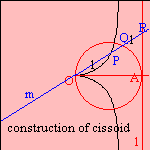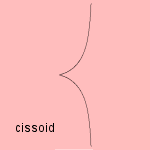|

The cissoid 1) can be constructed as follows:
Given a circle C with diameter OA and a tangent l through A. Now, draw lines m through O,
cutting circle C in point Q, line l in point R. Then the cissoid is the set of points P
for which OP = QR.  This
construction has been done by the Greek scholar Diocles (about 160 BC) 2).
He used the cissoid to solve the Delian problem, dealing with the duplication of the
cube. He did not use the name cissoid. The name of the curve, meaning 'ivy-shaped', is found for the first time in the
writings of the Greek Geminus (about 50 BC). Because
of Diocles' previous work on the curve his name has been added: cissoid
of Diocles. This
construction has been done by the Greek scholar Diocles (about 160 BC) 2).
He used the cissoid to solve the Delian problem, dealing with the duplication of the
cube. He did not use the name cissoid. The name of the curve, meaning 'ivy-shaped', is found for the first time in the
writings of the Greek Geminus (about 50 BC). Because
of Diocles' previous work on the curve his name has been added: cissoid
of Diocles.
Roberval and Fermat constructed the tangent of the cissoid (1634):
from a given point there are either one ore three tangents.
In 1658 Huygens and Wallis showed that the area between the curve and his asymptote is π/4.
The cissoid of Diocles is a special case of the generalized cissoid, where line l and circle C have
been substituted by arbitrary curves C1 and C2.
The curve, having one cusp and one asymptote, has as Cartesian coordinates:
x3 + xy2 - y2 = 0 or y2 = x3/(1-x)
Another generalization of the curve is the ophiuride.
 Some relationships with other curves are: Some relationships with other curves are:
In the special case that construction line l passes through the center of the circle,
the curve is a strophoid.
And near the cusp the curve approaches the form of a semicubic parabola.
notes
1) In Italian: cissoide di Diocle. 2) Waerden 1950
p.297
|






